Opportunity Evaluation Report: James Packer's Entrepreneurial Journey
VerifiedAdded on 2020/03/28
|10
|2386
|41
Report
AI Summary
This report provides an in-depth analysis of opportunity evaluation in the context of entrepreneurial business planning, using James Packer as a case study. It explores various opportunity evaluation tools, including the Timmons Model, design thinking, lean startup methodologies, and the business model canvas. The report examines James Packer's strategic decisions in the entertainment and tourism industries, highlighting his ability to identify and capitalize on market opportunities, such as his move from media to casinos and resorts. It also delves into the pathways entrepreneurs take, considering factors like market identification, problem-solving, scalability, and personal objectives. Furthermore, the report emphasizes the crucial roles of design thinking, lean startup, and business model canvas in modern entrepreneurship, advocating for innovative approaches to business planning. Finally, it provides recommendations for effective opportunity evaluation, covering aspects like long-term planning, strategic analysis, and resource allocation, to provide a comprehensive understanding of entrepreneurial success and how to achieve it.

Running head: OPPORTUNITY EVALUATION 1
Opportunity Evaluation
Name
Institution
Opportunity Evaluation
Name
Institution
Paraphrase This Document
Need a fresh take? Get an instant paraphrase of this document with our AI Paraphraser

OPPORTUNITY EVALUATION 2
Contents
Executive summary.....................................................................................................................2
Introduction..................................................................................................................................2
James Packer................................................................................................................................2
Opportunity Evaluation...............................................................................................................3
Pathways entrepreneurs take........................................................................................................5
The role of design thinking/lean-startup/business model canvas................................................6
Recommendations........................................................................................................................7
Conclusion...................................................................................................................................7
References....................................................................................................................................8
Executive summary
This report focuses on Entrepreneurial Business Planning by examining its vigorous
nature concerning James Packer. James Packer is a successful businessman with investments in
entertainment and tourism industry. This paper investigates James Packer based on opportunity
evaluation tools such as frameworks, design thinking, lean-startup and business model canvas.
These tools play a significant role in an entrepreneurial venture as they describe in details tools
available for entrepreneurs to evaluate the opportunity, selecting paths for various ventures,
articulate the role of design thinking among others such as the role of lean-startup and
consideration of business model canvas for entrepreneurs.
Contents
Executive summary.....................................................................................................................2
Introduction..................................................................................................................................2
James Packer................................................................................................................................2
Opportunity Evaluation...............................................................................................................3
Pathways entrepreneurs take........................................................................................................5
The role of design thinking/lean-startup/business model canvas................................................6
Recommendations........................................................................................................................7
Conclusion...................................................................................................................................7
References....................................................................................................................................8
Executive summary
This report focuses on Entrepreneurial Business Planning by examining its vigorous
nature concerning James Packer. James Packer is a successful businessman with investments in
entertainment and tourism industry. This paper investigates James Packer based on opportunity
evaluation tools such as frameworks, design thinking, lean-startup and business model canvas.
These tools play a significant role in an entrepreneurial venture as they describe in details tools
available for entrepreneurs to evaluate the opportunity, selecting paths for various ventures,
articulate the role of design thinking among others such as the role of lean-startup and
consideration of business model canvas for entrepreneurs.

OPPORTUNITY EVALUATION 3
Introduction
The entrepreneurial venture is a plan of activities developed by an individual aiming at
starting and running a business without sufficient resources (Mishra & Zachary, 2015). An
entrepreneurial venture is different from other forms of conducting business as it relates to
innovation, service or product. Entrepreneurs like James Packer possess certain principles that
play a critical role in the success of their businesses. Such principles include flexibility in their
thinking, they are highly motivated, persistent, and can thrive in the harsh working environment
(Elliott & Boshoff, 2008). James Packer is a successful entrepreneur as a result of his ability to
take initiatives by overcoming challenges to ensure that the objective set is achieved as expected.
James Packer
James Packer began his entrepreneurial venture after taking control of his parent's
company. Over the years James realized that the ball game was changing and media companies
were going to lose advertising shares because of the growth of online advertising. As a result,
James Packer decided to sell stakes in media companies that he acquired through inheritance.
After selling all the shares, he began investing in casinos and resorts that earned him a name in
the gambling as well as the tourism industry. James owns Crown Resorts situated in Australia,
London and Philippines. His resorts have villas for essential personnel, gaming sections,
swimming pools, luxury spas among other entertainment activities.
Packer’s resorts are said to attract more than 25 million people in a year mainly of Asian
descent. Although James has been successful in his entrepreneurial venture, he has equally
encountered losses in his quest to make the gambling empire a reality. James invested a quarter a
billion in a casino in the United States that failed as well as the similar amount that was lost
when he wanted to acquire a stake in Station Casinos. James Packer began appearing in
Introduction
The entrepreneurial venture is a plan of activities developed by an individual aiming at
starting and running a business without sufficient resources (Mishra & Zachary, 2015). An
entrepreneurial venture is different from other forms of conducting business as it relates to
innovation, service or product. Entrepreneurs like James Packer possess certain principles that
play a critical role in the success of their businesses. Such principles include flexibility in their
thinking, they are highly motivated, persistent, and can thrive in the harsh working environment
(Elliott & Boshoff, 2008). James Packer is a successful entrepreneur as a result of his ability to
take initiatives by overcoming challenges to ensure that the objective set is achieved as expected.
James Packer
James Packer began his entrepreneurial venture after taking control of his parent's
company. Over the years James realized that the ball game was changing and media companies
were going to lose advertising shares because of the growth of online advertising. As a result,
James Packer decided to sell stakes in media companies that he acquired through inheritance.
After selling all the shares, he began investing in casinos and resorts that earned him a name in
the gambling as well as the tourism industry. James owns Crown Resorts situated in Australia,
London and Philippines. His resorts have villas for essential personnel, gaming sections,
swimming pools, luxury spas among other entertainment activities.
Packer’s resorts are said to attract more than 25 million people in a year mainly of Asian
descent. Although James has been successful in his entrepreneurial venture, he has equally
encountered losses in his quest to make the gambling empire a reality. James invested a quarter a
billion in a casino in the United States that failed as well as the similar amount that was lost
when he wanted to acquire a stake in Station Casinos. James Packer began appearing in
⊘ This is a preview!⊘
Do you want full access?
Subscribe today to unlock all pages.

Trusted by 1+ million students worldwide

OPPORTUNITY EVALUATION 4
entrepreneurial wealth list after 2006, a year after his father’s death. Packer is reported to have
lost a significant portion of his money as a result of struggling profits as well as poor investment
skills. In 2009 Packer’s wealth had substantially reduced significantly and he sold some of his
major assets including a yacht. Additionally, Packer’s wealth reduced further after dividing the
inheritance with his sister.
As of 2016, Packer’s net worth was reported to be fewer than 3.5 billion dollars. He has
since dropped to 6th place among the richest people in Australia. Whether his investments in
entertainment and gambling are going to pay off is a matter of time.
Opportunity Evaluation
There are several tools available for evaluating a business opportunity and vary based on
the nature of the business. To begin with, Timmons Model of the Entrepreneurial Process is an
opportunity evaluation tool that focuses on three broad categories which include the workers,
resources and the nature surrounding the opportunity (Matthews, Schenkel, Ford & Human,
2009). Applying this method, it can then be said that James Packer used the resources and team
available to him to study the characteristics of media venture which his companies managed. It is
at this point that he realized that advertising revenue would soon be consumed by online
advertisement. It is here that Packer managed to acquire stakes in online businesses, SEEK and
Carsales.
After six years, Packer sold his stake for 440 million dollars after an initial purchase of
33 million dollars. Besides the three elements, Timmons provides other measures for evaluating
a potential business opportunity (Matthews, Schenkel, Ford & Human, 2009). These measures
include the industry, market, economic and personal factors. After the fall of One Tel, Packer
entrepreneurial wealth list after 2006, a year after his father’s death. Packer is reported to have
lost a significant portion of his money as a result of struggling profits as well as poor investment
skills. In 2009 Packer’s wealth had substantially reduced significantly and he sold some of his
major assets including a yacht. Additionally, Packer’s wealth reduced further after dividing the
inheritance with his sister.
As of 2016, Packer’s net worth was reported to be fewer than 3.5 billion dollars. He has
since dropped to 6th place among the richest people in Australia. Whether his investments in
entertainment and gambling are going to pay off is a matter of time.
Opportunity Evaluation
There are several tools available for evaluating a business opportunity and vary based on
the nature of the business. To begin with, Timmons Model of the Entrepreneurial Process is an
opportunity evaluation tool that focuses on three broad categories which include the workers,
resources and the nature surrounding the opportunity (Matthews, Schenkel, Ford & Human,
2009). Applying this method, it can then be said that James Packer used the resources and team
available to him to study the characteristics of media venture which his companies managed. It is
at this point that he realized that advertising revenue would soon be consumed by online
advertisement. It is here that Packer managed to acquire stakes in online businesses, SEEK and
Carsales.
After six years, Packer sold his stake for 440 million dollars after an initial purchase of
33 million dollars. Besides the three elements, Timmons provides other measures for evaluating
a potential business opportunity (Matthews, Schenkel, Ford & Human, 2009). These measures
include the industry, market, economic and personal factors. After the fall of One Tel, Packer
Paraphrase This Document
Need a fresh take? Get an instant paraphrase of this document with our AI Paraphraser
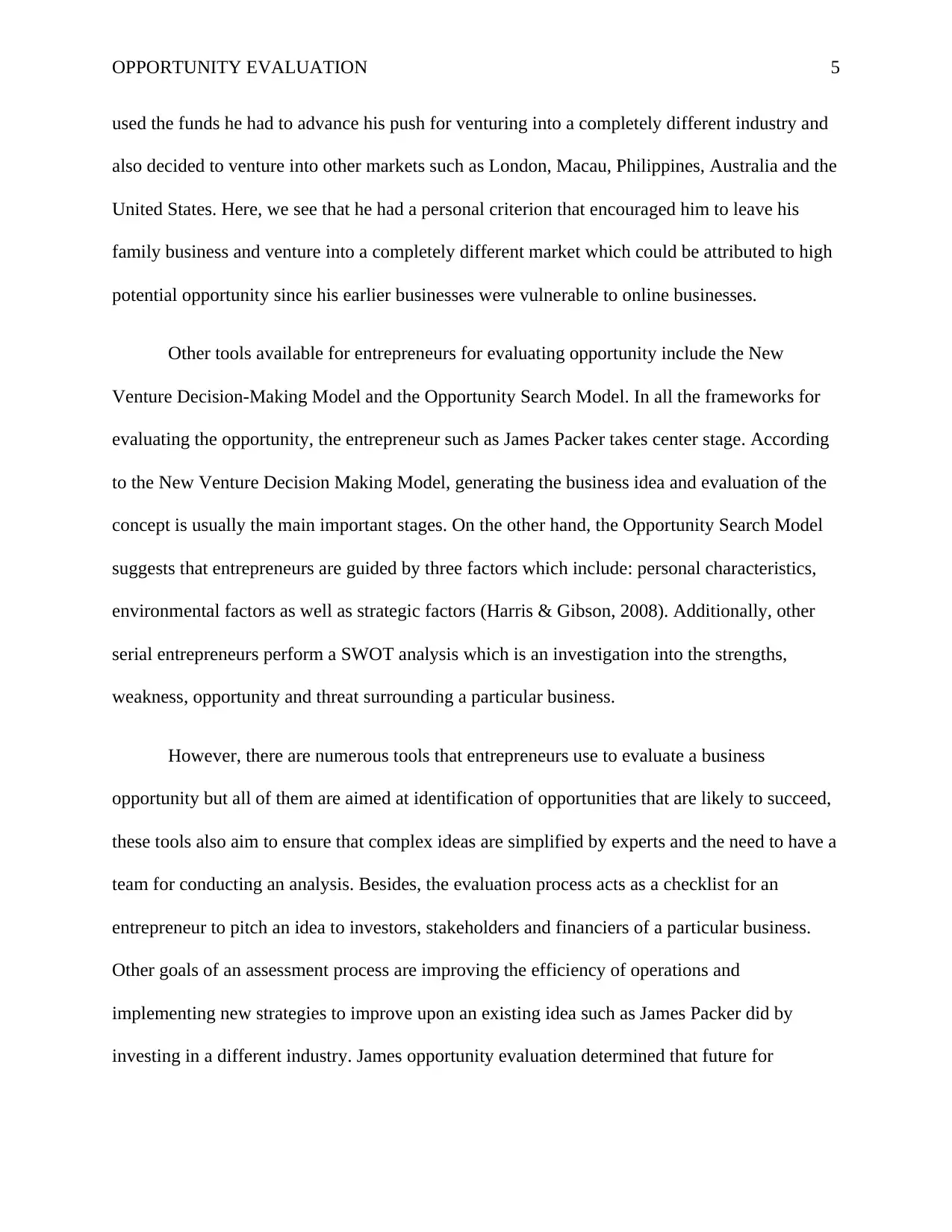
OPPORTUNITY EVALUATION 5
used the funds he had to advance his push for venturing into a completely different industry and
also decided to venture into other markets such as London, Macau, Philippines, Australia and the
United States. Here, we see that he had a personal criterion that encouraged him to leave his
family business and venture into a completely different market which could be attributed to high
potential opportunity since his earlier businesses were vulnerable to online businesses.
Other tools available for entrepreneurs for evaluating opportunity include the New
Venture Decision-Making Model and the Opportunity Search Model. In all the frameworks for
evaluating the opportunity, the entrepreneur such as James Packer takes center stage. According
to the New Venture Decision Making Model, generating the business idea and evaluation of the
concept is usually the main important stages. On the other hand, the Opportunity Search Model
suggests that entrepreneurs are guided by three factors which include: personal characteristics,
environmental factors as well as strategic factors (Harris & Gibson, 2008). Additionally, other
serial entrepreneurs perform a SWOT analysis which is an investigation into the strengths,
weakness, opportunity and threat surrounding a particular business.
However, there are numerous tools that entrepreneurs use to evaluate a business
opportunity but all of them are aimed at identification of opportunities that are likely to succeed,
these tools also aim to ensure that complex ideas are simplified by experts and the need to have a
team for conducting an analysis. Besides, the evaluation process acts as a checklist for an
entrepreneur to pitch an idea to investors, stakeholders and financiers of a particular business.
Other goals of an assessment process are improving the efficiency of operations and
implementing new strategies to improve upon an existing idea such as James Packer did by
investing in a different industry. James opportunity evaluation determined that future for
used the funds he had to advance his push for venturing into a completely different industry and
also decided to venture into other markets such as London, Macau, Philippines, Australia and the
United States. Here, we see that he had a personal criterion that encouraged him to leave his
family business and venture into a completely different market which could be attributed to high
potential opportunity since his earlier businesses were vulnerable to online businesses.
Other tools available for entrepreneurs for evaluating opportunity include the New
Venture Decision-Making Model and the Opportunity Search Model. In all the frameworks for
evaluating the opportunity, the entrepreneur such as James Packer takes center stage. According
to the New Venture Decision Making Model, generating the business idea and evaluation of the
concept is usually the main important stages. On the other hand, the Opportunity Search Model
suggests that entrepreneurs are guided by three factors which include: personal characteristics,
environmental factors as well as strategic factors (Harris & Gibson, 2008). Additionally, other
serial entrepreneurs perform a SWOT analysis which is an investigation into the strengths,
weakness, opportunity and threat surrounding a particular business.
However, there are numerous tools that entrepreneurs use to evaluate a business
opportunity but all of them are aimed at identification of opportunities that are likely to succeed,
these tools also aim to ensure that complex ideas are simplified by experts and the need to have a
team for conducting an analysis. Besides, the evaluation process acts as a checklist for an
entrepreneur to pitch an idea to investors, stakeholders and financiers of a particular business.
Other goals of an assessment process are improving the efficiency of operations and
implementing new strategies to improve upon an existing idea such as James Packer did by
investing in a different industry. James opportunity evaluation determined that future for
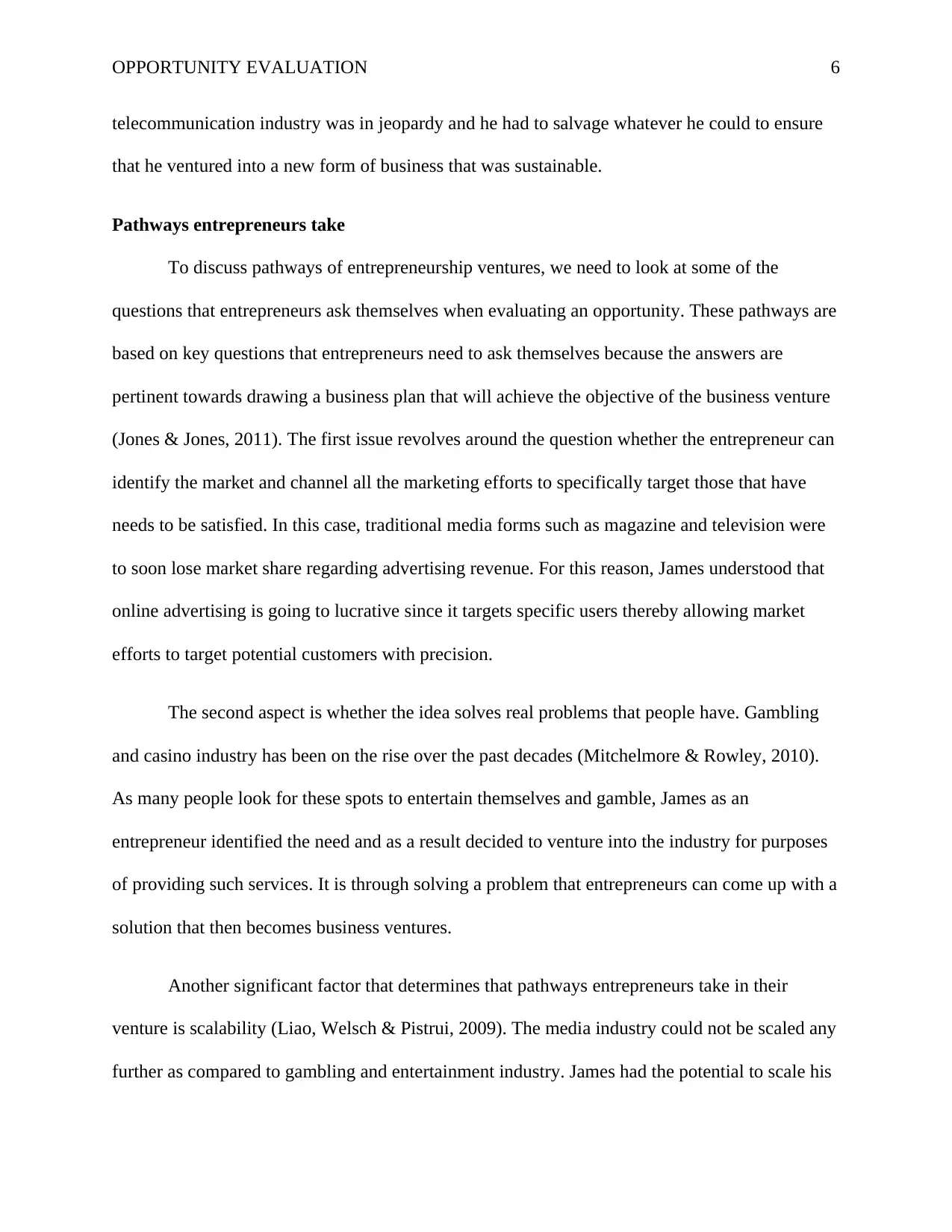
OPPORTUNITY EVALUATION 6
telecommunication industry was in jeopardy and he had to salvage whatever he could to ensure
that he ventured into a new form of business that was sustainable.
Pathways entrepreneurs take
To discuss pathways of entrepreneurship ventures, we need to look at some of the
questions that entrepreneurs ask themselves when evaluating an opportunity. These pathways are
based on key questions that entrepreneurs need to ask themselves because the answers are
pertinent towards drawing a business plan that will achieve the objective of the business venture
(Jones & Jones, 2011). The first issue revolves around the question whether the entrepreneur can
identify the market and channel all the marketing efforts to specifically target those that have
needs to be satisfied. In this case, traditional media forms such as magazine and television were
to soon lose market share regarding advertising revenue. For this reason, James understood that
online advertising is going to lucrative since it targets specific users thereby allowing market
efforts to target potential customers with precision.
The second aspect is whether the idea solves real problems that people have. Gambling
and casino industry has been on the rise over the past decades (Mitchelmore & Rowley, 2010).
As many people look for these spots to entertain themselves and gamble, James as an
entrepreneur identified the need and as a result decided to venture into the industry for purposes
of providing such services. It is through solving a problem that entrepreneurs can come up with a
solution that then becomes business ventures.
Another significant factor that determines that pathways entrepreneurs take in their
venture is scalability (Liao, Welsch & Pistrui, 2009). The media industry could not be scaled any
further as compared to gambling and entertainment industry. James had the potential to scale his
telecommunication industry was in jeopardy and he had to salvage whatever he could to ensure
that he ventured into a new form of business that was sustainable.
Pathways entrepreneurs take
To discuss pathways of entrepreneurship ventures, we need to look at some of the
questions that entrepreneurs ask themselves when evaluating an opportunity. These pathways are
based on key questions that entrepreneurs need to ask themselves because the answers are
pertinent towards drawing a business plan that will achieve the objective of the business venture
(Jones & Jones, 2011). The first issue revolves around the question whether the entrepreneur can
identify the market and channel all the marketing efforts to specifically target those that have
needs to be satisfied. In this case, traditional media forms such as magazine and television were
to soon lose market share regarding advertising revenue. For this reason, James understood that
online advertising is going to lucrative since it targets specific users thereby allowing market
efforts to target potential customers with precision.
The second aspect is whether the idea solves real problems that people have. Gambling
and casino industry has been on the rise over the past decades (Mitchelmore & Rowley, 2010).
As many people look for these spots to entertain themselves and gamble, James as an
entrepreneur identified the need and as a result decided to venture into the industry for purposes
of providing such services. It is through solving a problem that entrepreneurs can come up with a
solution that then becomes business ventures.
Another significant factor that determines that pathways entrepreneurs take in their
venture is scalability (Liao, Welsch & Pistrui, 2009). The media industry could not be scaled any
further as compared to gambling and entertainment industry. James had the potential to scale his
⊘ This is a preview!⊘
Do you want full access?
Subscribe today to unlock all pages.

Trusted by 1+ million students worldwide
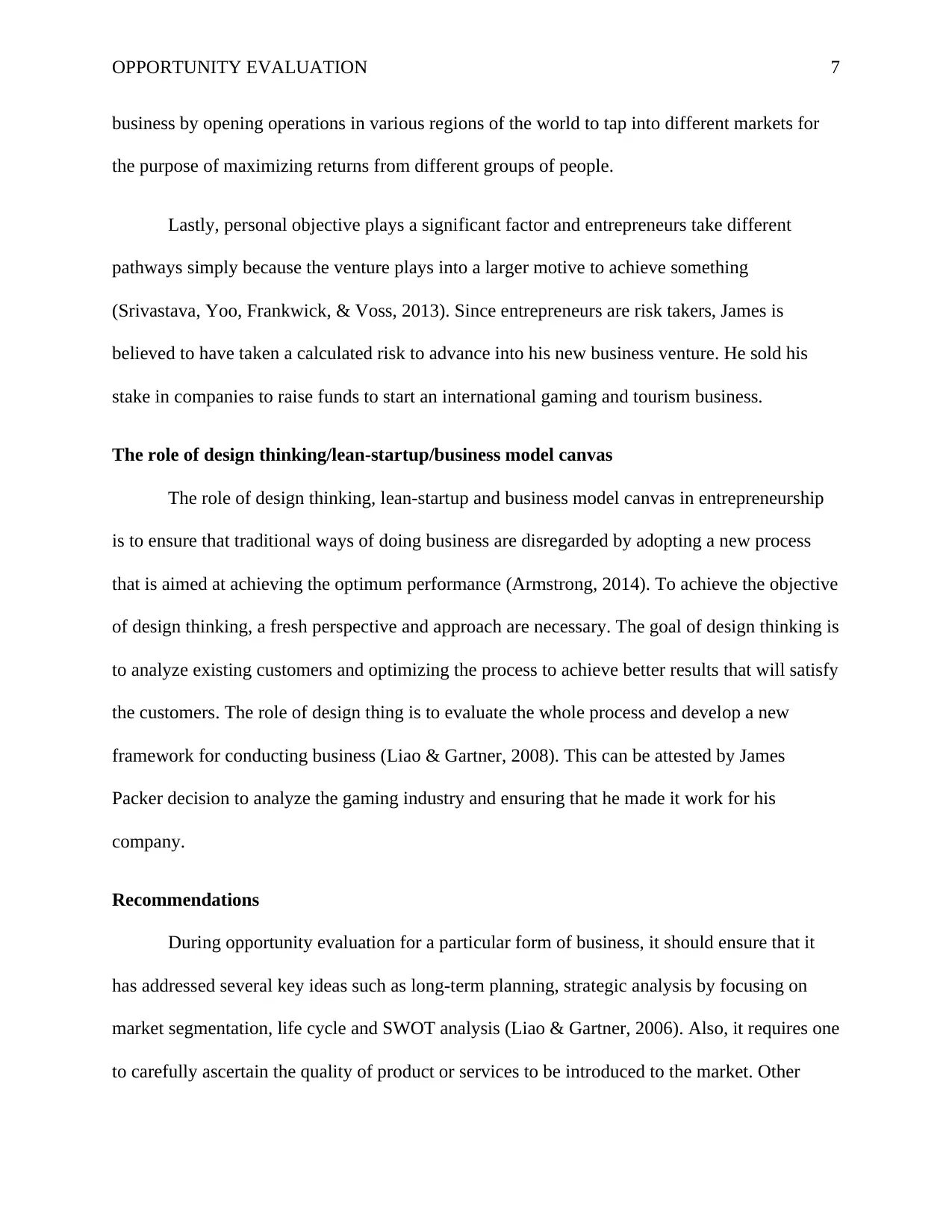
OPPORTUNITY EVALUATION 7
business by opening operations in various regions of the world to tap into different markets for
the purpose of maximizing returns from different groups of people.
Lastly, personal objective plays a significant factor and entrepreneurs take different
pathways simply because the venture plays into a larger motive to achieve something
(Srivastava, Yoo, Frankwick, & Voss, 2013). Since entrepreneurs are risk takers, James is
believed to have taken a calculated risk to advance into his new business venture. He sold his
stake in companies to raise funds to start an international gaming and tourism business.
The role of design thinking/lean-startup/business model canvas
The role of design thinking, lean-startup and business model canvas in entrepreneurship
is to ensure that traditional ways of doing business are disregarded by adopting a new process
that is aimed at achieving the optimum performance (Armstrong, 2014). To achieve the objective
of design thinking, a fresh perspective and approach are necessary. The goal of design thinking is
to analyze existing customers and optimizing the process to achieve better results that will satisfy
the customers. The role of design thing is to evaluate the whole process and develop a new
framework for conducting business (Liao & Gartner, 2008). This can be attested by James
Packer decision to analyze the gaming industry and ensuring that he made it work for his
company.
Recommendations
During opportunity evaluation for a particular form of business, it should ensure that it
has addressed several key ideas such as long-term planning, strategic analysis by focusing on
market segmentation, life cycle and SWOT analysis (Liao & Gartner, 2006). Also, it requires one
to carefully ascertain the quality of product or services to be introduced to the market. Other
business by opening operations in various regions of the world to tap into different markets for
the purpose of maximizing returns from different groups of people.
Lastly, personal objective plays a significant factor and entrepreneurs take different
pathways simply because the venture plays into a larger motive to achieve something
(Srivastava, Yoo, Frankwick, & Voss, 2013). Since entrepreneurs are risk takers, James is
believed to have taken a calculated risk to advance into his new business venture. He sold his
stake in companies to raise funds to start an international gaming and tourism business.
The role of design thinking/lean-startup/business model canvas
The role of design thinking, lean-startup and business model canvas in entrepreneurship
is to ensure that traditional ways of doing business are disregarded by adopting a new process
that is aimed at achieving the optimum performance (Armstrong, 2014). To achieve the objective
of design thinking, a fresh perspective and approach are necessary. The goal of design thinking is
to analyze existing customers and optimizing the process to achieve better results that will satisfy
the customers. The role of design thing is to evaluate the whole process and develop a new
framework for conducting business (Liao & Gartner, 2008). This can be attested by James
Packer decision to analyze the gaming industry and ensuring that he made it work for his
company.
Recommendations
During opportunity evaluation for a particular form of business, it should ensure that it
has addressed several key ideas such as long-term planning, strategic analysis by focusing on
market segmentation, life cycle and SWOT analysis (Liao & Gartner, 2006). Also, it requires one
to carefully ascertain the quality of product or services to be introduced to the market. Other
Paraphrase This Document
Need a fresh take? Get an instant paraphrase of this document with our AI Paraphraser
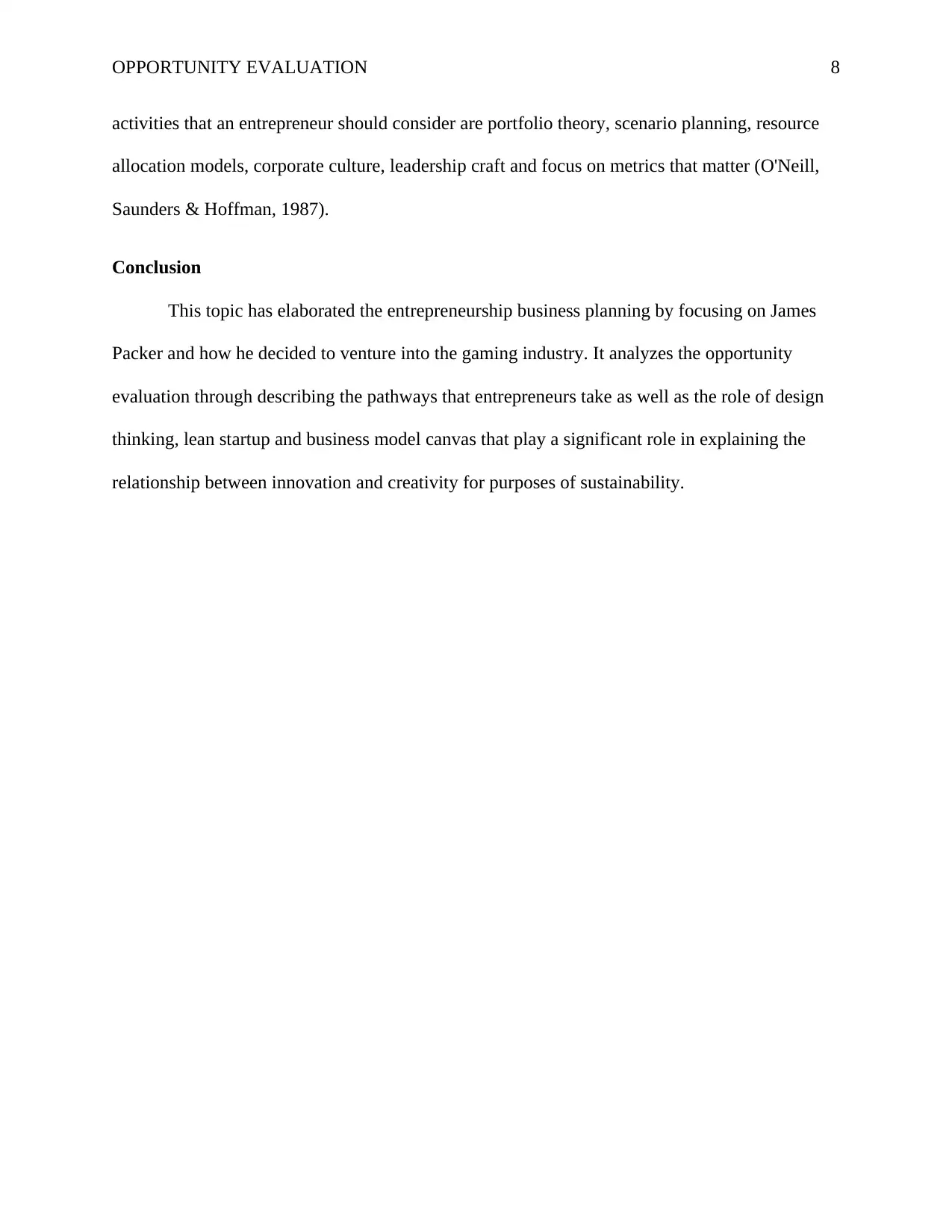
OPPORTUNITY EVALUATION 8
activities that an entrepreneur should consider are portfolio theory, scenario planning, resource
allocation models, corporate culture, leadership craft and focus on metrics that matter (O'Neill,
Saunders & Hoffman, 1987).
Conclusion
This topic has elaborated the entrepreneurship business planning by focusing on James
Packer and how he decided to venture into the gaming industry. It analyzes the opportunity
evaluation through describing the pathways that entrepreneurs take as well as the role of design
thinking, lean startup and business model canvas that play a significant role in explaining the
relationship between innovation and creativity for purposes of sustainability.
activities that an entrepreneur should consider are portfolio theory, scenario planning, resource
allocation models, corporate culture, leadership craft and focus on metrics that matter (O'Neill,
Saunders & Hoffman, 1987).
Conclusion
This topic has elaborated the entrepreneurship business planning by focusing on James
Packer and how he decided to venture into the gaming industry. It analyzes the opportunity
evaluation through describing the pathways that entrepreneurs take as well as the role of design
thinking, lean startup and business model canvas that play a significant role in explaining the
relationship between innovation and creativity for purposes of sustainability.
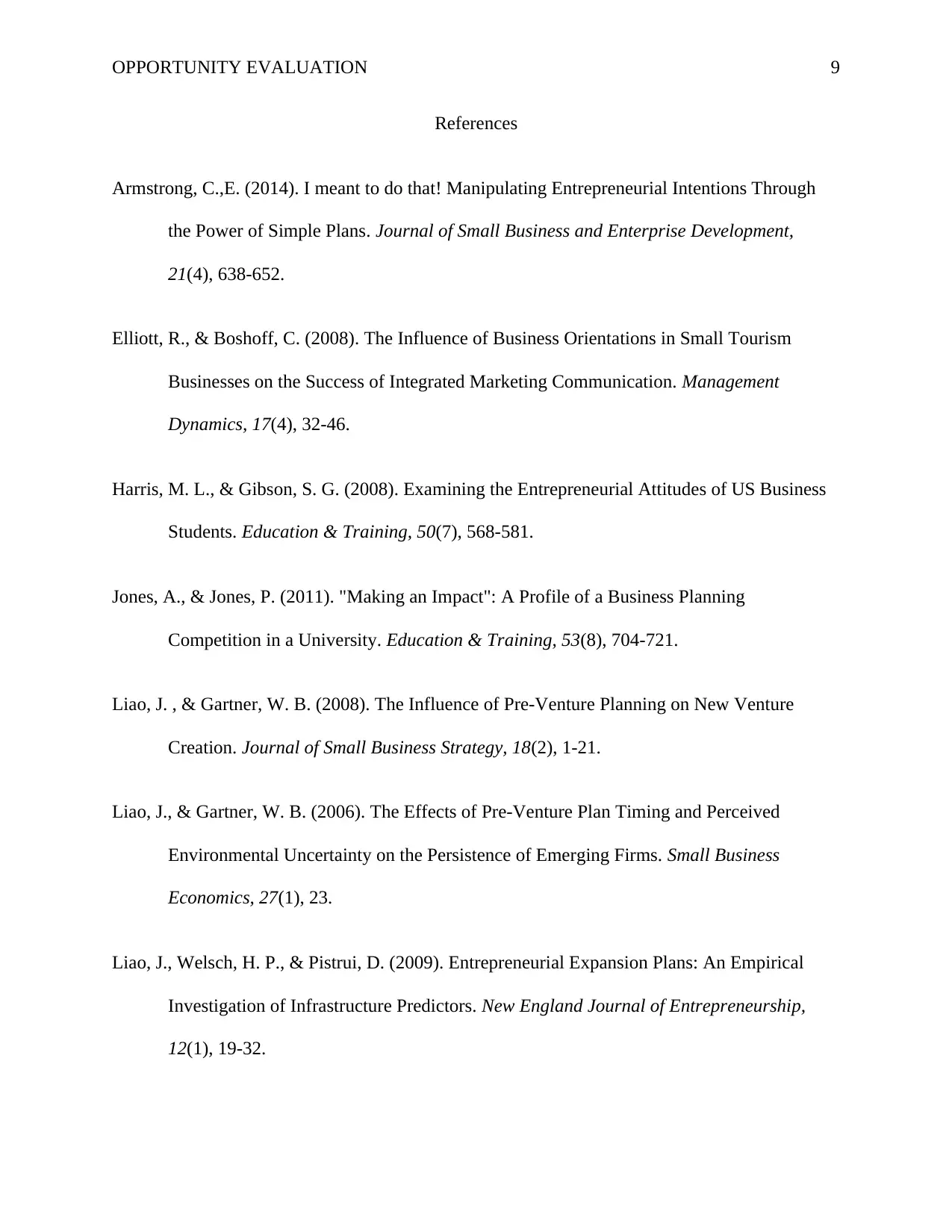
OPPORTUNITY EVALUATION 9
References
Armstrong, C.,E. (2014). I meant to do that! Manipulating Entrepreneurial Intentions Through
the Power of Simple Plans. Journal of Small Business and Enterprise Development,
21(4), 638-652.
Elliott, R., & Boshoff, C. (2008). The Influence of Business Orientations in Small Tourism
Businesses on the Success of Integrated Marketing Communication. Management
Dynamics, 17(4), 32-46.
Harris, M. L., & Gibson, S. G. (2008). Examining the Entrepreneurial Attitudes of US Business
Students. Education & Training, 50(7), 568-581.
Jones, A., & Jones, P. (2011). "Making an Impact": A Profile of a Business Planning
Competition in a University. Education & Training, 53(8), 704-721.
Liao, J. , & Gartner, W. B. (2008). The Influence of Pre-Venture Planning on New Venture
Creation. Journal of Small Business Strategy, 18(2), 1-21.
Liao, J., & Gartner, W. B. (2006). The Effects of Pre-Venture Plan Timing and Perceived
Environmental Uncertainty on the Persistence of Emerging Firms. Small Business
Economics, 27(1), 23.
Liao, J., Welsch, H. P., & Pistrui, D. (2009). Entrepreneurial Expansion Plans: An Empirical
Investigation of Infrastructure Predictors. New England Journal of Entrepreneurship,
12(1), 19-32.
References
Armstrong, C.,E. (2014). I meant to do that! Manipulating Entrepreneurial Intentions Through
the Power of Simple Plans. Journal of Small Business and Enterprise Development,
21(4), 638-652.
Elliott, R., & Boshoff, C. (2008). The Influence of Business Orientations in Small Tourism
Businesses on the Success of Integrated Marketing Communication. Management
Dynamics, 17(4), 32-46.
Harris, M. L., & Gibson, S. G. (2008). Examining the Entrepreneurial Attitudes of US Business
Students. Education & Training, 50(7), 568-581.
Jones, A., & Jones, P. (2011). "Making an Impact": A Profile of a Business Planning
Competition in a University. Education & Training, 53(8), 704-721.
Liao, J. , & Gartner, W. B. (2008). The Influence of Pre-Venture Planning on New Venture
Creation. Journal of Small Business Strategy, 18(2), 1-21.
Liao, J., & Gartner, W. B. (2006). The Effects of Pre-Venture Plan Timing and Perceived
Environmental Uncertainty on the Persistence of Emerging Firms. Small Business
Economics, 27(1), 23.
Liao, J., Welsch, H. P., & Pistrui, D. (2009). Entrepreneurial Expansion Plans: An Empirical
Investigation of Infrastructure Predictors. New England Journal of Entrepreneurship,
12(1), 19-32.
⊘ This is a preview!⊘
Do you want full access?
Subscribe today to unlock all pages.

Trusted by 1+ million students worldwide
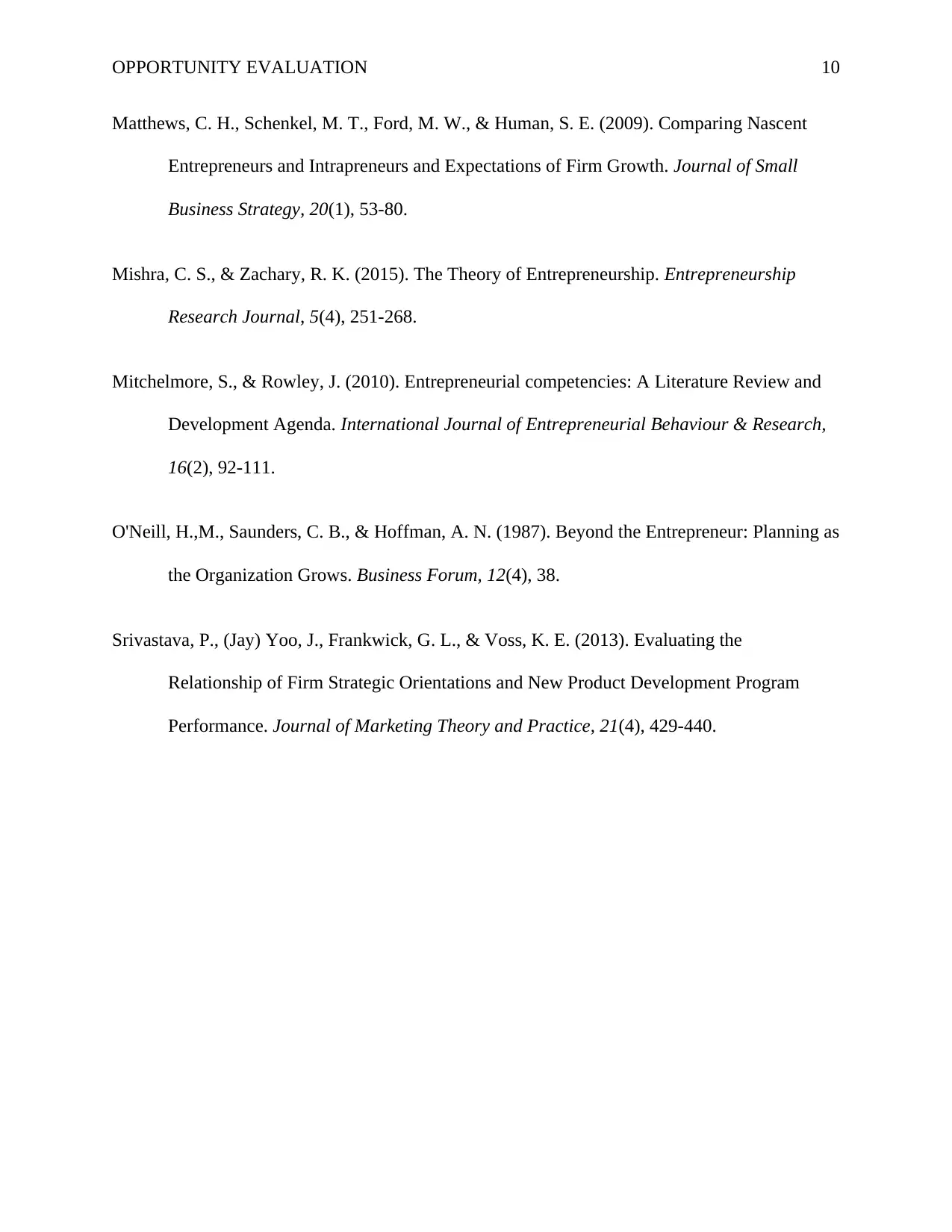
OPPORTUNITY EVALUATION 10
Matthews, C. H., Schenkel, M. T., Ford, M. W., & Human, S. E. (2009). Comparing Nascent
Entrepreneurs and Intrapreneurs and Expectations of Firm Growth. Journal of Small
Business Strategy, 20(1), 53-80.
Mishra, C. S., & Zachary, R. K. (2015). The Theory of Entrepreneurship. Entrepreneurship
Research Journal, 5(4), 251-268.
Mitchelmore, S., & Rowley, J. (2010). Entrepreneurial competencies: A Literature Review and
Development Agenda. International Journal of Entrepreneurial Behaviour & Research,
16(2), 92-111.
O'Neill, H.,M., Saunders, C. B., & Hoffman, A. N. (1987). Beyond the Entrepreneur: Planning as
the Organization Grows. Business Forum, 12(4), 38.
Srivastava, P., (Jay) Yoo, J., Frankwick, G. L., & Voss, K. E. (2013). Evaluating the
Relationship of Firm Strategic Orientations and New Product Development Program
Performance. Journal of Marketing Theory and Practice, 21(4), 429-440.
Matthews, C. H., Schenkel, M. T., Ford, M. W., & Human, S. E. (2009). Comparing Nascent
Entrepreneurs and Intrapreneurs and Expectations of Firm Growth. Journal of Small
Business Strategy, 20(1), 53-80.
Mishra, C. S., & Zachary, R. K. (2015). The Theory of Entrepreneurship. Entrepreneurship
Research Journal, 5(4), 251-268.
Mitchelmore, S., & Rowley, J. (2010). Entrepreneurial competencies: A Literature Review and
Development Agenda. International Journal of Entrepreneurial Behaviour & Research,
16(2), 92-111.
O'Neill, H.,M., Saunders, C. B., & Hoffman, A. N. (1987). Beyond the Entrepreneur: Planning as
the Organization Grows. Business Forum, 12(4), 38.
Srivastava, P., (Jay) Yoo, J., Frankwick, G. L., & Voss, K. E. (2013). Evaluating the
Relationship of Firm Strategic Orientations and New Product Development Program
Performance. Journal of Marketing Theory and Practice, 21(4), 429-440.
1 out of 10
Your All-in-One AI-Powered Toolkit for Academic Success.
+13062052269
info@desklib.com
Available 24*7 on WhatsApp / Email
![[object Object]](/_next/static/media/star-bottom.7253800d.svg)
Unlock your academic potential
Copyright © 2020–2025 A2Z Services. All Rights Reserved. Developed and managed by ZUCOL.


